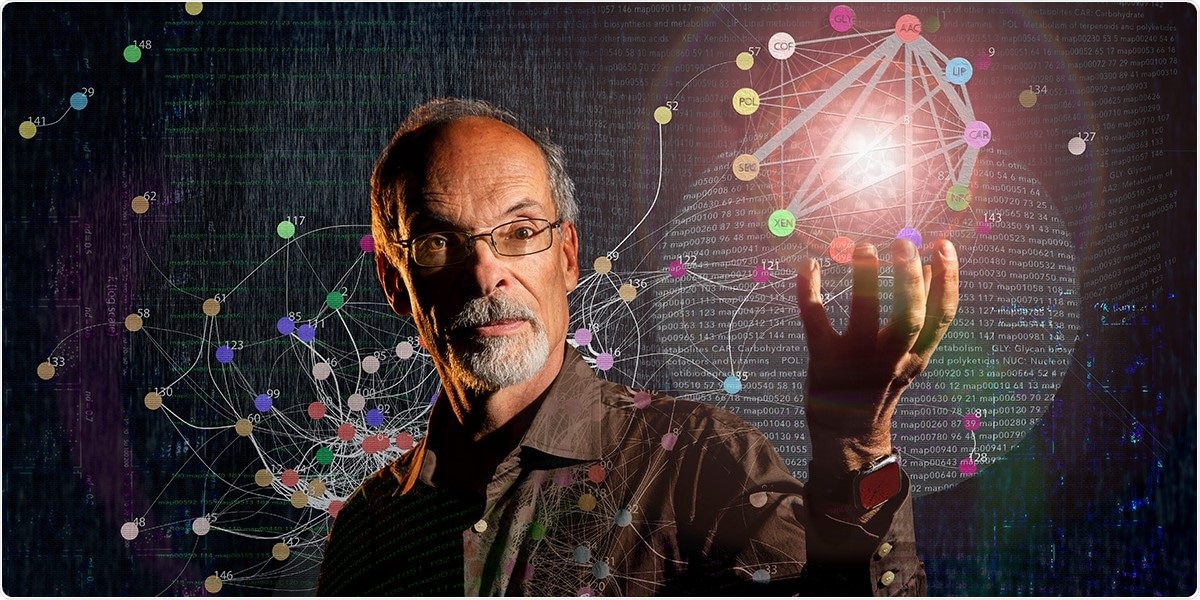Since the start of the COVID-19 epidemic, proteins have been stealthily taking over human lives. Humans have been living at the mercy of the virus’s so-called “spike” protein, which has mutated several times, resulting in progressively lethal forms. But the truth is that proteins have always ruled humans. They are in charge of almost everything at the cellular level.

Gustavo Caetano-Anolles surrounded by depiction of molecular networks. Image by Fred Zwicky.
Proteins are so basic that DNA—the genetic material that distinguishes each of us—is just a continuous sequence of protein blueprints. Animals, plants, fungi, bacteria, archaea, and even viruses fall under this category. Proteins and their constituent pieces, like those groupings of animals, evolve and change over time.
The evolutionary history and interrelationships of protein domains, the constituents of protein molecules, are mapped across 3.8 billion years in a new study published in Scientific Reports by University of Illinois researchers.
Knowing how and why domains combine in proteins during evolution could help scientists understand and engineer the activity of proteins for medicine and bioengineering applications. For example, these insights could guide disease management, such as making better vaccines from the spike protein of COVID-19 viruses.”
Gustavo Caetano-Anollés, Study Senior Author and Professor, Department of Crop Sciences, University of Illinois
Caetano-Anollés is also a member of Illinois’ Carl R. Woese Institute for Genomic Biology. He has been studying COVID mutations from the beginning of the pandemic, but that chronology represents a tiny part of what he and Ph.D. student Fayez Aziz addressed in their current research.
The researchers collated millions of protein sequences encoded in hundreds of genomes from all taxonomic groupings, including higher species and bacteria, to construct sequences and structures. They concentrated on structural domains rather than complete proteins.
Most proteins are made of more than one domain. These are compact structural units, or modules, that harbor specialized functions. More importantly, they are the units of evolution.”
Gustavo Caetano-Anollés, Study Senior Author and Professor, Department of Crop Sciences, University of Illinois
They started developing a network to understand how domains have evolved and been shared across proteins throughout billions of years of evolution after sorting proteins into domains to build evolutionary trees.
We built a time series of networks that describe how domains have accumulated and how proteins have rearranged their domains through evolution. This is the first time such a network of 'domain organization’ has been studied as an evolutionary chronology. Our survey revealed there is a vast evolving network describing how domains combine with each other in proteins.”
Fayez Aziz, Doctoral Student, University of Illinois
Each network connection symbolizes a time when a certain domain was recruited into a protein, usually to execute a novel function.
“This fact alone strongly suggests domain recruitment is a powerful force in nature,” said Fayez Aziz.
The timeline also revealed which domains were responsible for specific protein functions. The researchers were able to track out the origins of domains involved in environmental sensing as well as secondary metabolites, or poisons utilized in bacterial and plant defenses.
Domains began to combine early in protein evolution, but there were also periods of rapid network expansion, according to the study. The researchers, for instance, describe a 1.5-billion-year-old “big bang” of domain combinations that coincided with the emergence of multicellular creatures and eukaryotes, which include humans.
Biological big bangs are not a novel concept. The large and early genesis of metabolism was originally documented by Caetano-Anollés' team, and they just discovered it again while following the development of metabolic networks.
The historical record of a big bang, which describes the evolutionary patchwork of proteins, provides new techniques for understanding protein composition.
“This could help identify, for example, why structural variations and genomic recombination’s occur often in SARS-CoV-2,” said Caetano-Anollés.
He goes on to say that this new technique of looking at proteins could help avert pandemics by revealing how virus illnesses start. It could also assist to prevent disease outbreaks by enhancing vaccine design.
Source:
Journal reference:
Aziz, M. F. & Caetano-Anollés, G., (2021) Evolution of networks of protein domain organization. Scientific Reports. doi.org/10.1038/s41598-021-90498-8.